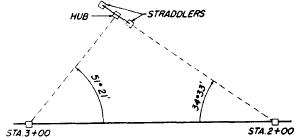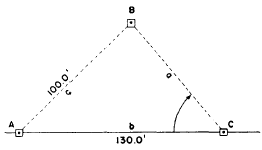|
Setting Points When Given
Angles
from Two Stations To set a point when given the angle from each
of
two traverse stations, you should ordinarily

Figure 13-25.-Setting a point by the use of straddlers.
use a pair of straddle hubs (commonly called STRADDLERS),
as shown in figure 13-25. Here the
point was to be located at an angle of 3433 from
station 2 + 00 and at an angle of 5121 from
station 3 + 00. The transit was set up at station
2 + 00, sighted on station 3 + 00, and an angle
of 3433 was turned to the right. On this line
of sight, a pair of straddle hubs was driven, one
on either side of the estimated point of inter-section of
the tie lines. A cord was stretched between
the straddlers.
The transit was then shifted to station 3 + 00, sighted
on station 2 + 00, and an angle of 5121 was
turned to the left. A hub was driven at the point
where this line of sight intercepted the cord between
the straddlers.
Setting Points When Given an
Angle from One Station and the
Distance from Another
To set a point with a given angle from one station
and the distance from another, you would find
it best to determine the direction of the distance
line by triangle solution. In figure 13-26,

Figure 13-26.-Locating a point by angle and distance from
two
stations.
point B is to be located 100.0 ft from station A
and
at an angle of 5000 from station C. In
this example, you can determine the size of
the angle at A by first determining the size of angle
B, then subtracting the sum of angles B and C
from 180. The solution for angle B is as follows:

Angle B then measures, to the nearest minute, 8447.
Therefore, angle A measures

Set up a transit at A, sight on C, and
turn 4513 to the left. Then,
you set B by measuring off 100.0 ft
on this line of sight. As a check, you set
up the transit at C, sight on A, turn 5000 to
the right, and make sure this line of sight intercepts
the marker at B.
|







